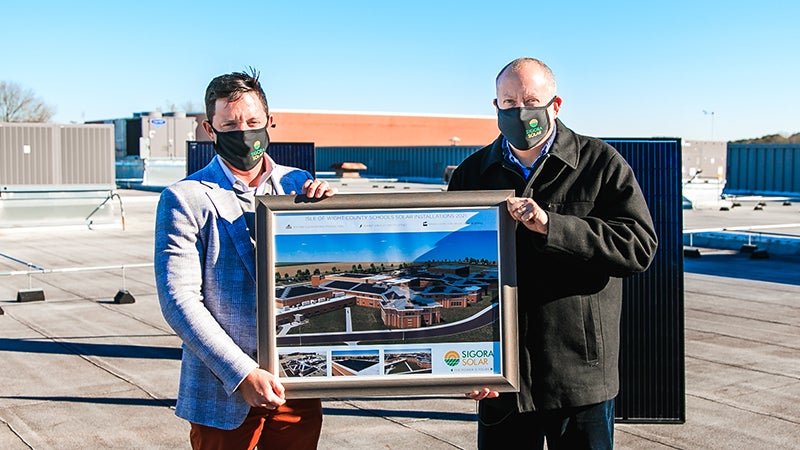IW schools celebrate solar project
Published 7:15 pm Tuesday, February 9, 2021

- Logan Landry, left, CEO of Sigora Solar, and Jim Thornton, superintendent of Isle of Wight County Schools, pose with a plaque commemorating the start of solar power systems at seven of the division’s nine school campuses. The solar installations are anticipated to save thousands of dollars a year and provide both renewable energy and learning experiences for students, officials said.
Isle of Wight County Schools formally launched its partnership with Sigora Solar on Feb. 2.
The school division and the company produced a previously recorded virtual ceremony and published it on Facebook and YouTube on Feb. 2. It features students, school leaders and company representatives. School and company representatives opted for the virtual ceremony out of concern and respect for everyone’s health during the coronavirus pandemic.
Through the partnership, solar power systems will be installed at seven of the county’s nine school campuses. Sigora and the school division have signed a power purchasing agreement, which means there is limited upfront costs for the county.
The solar panel systems are expected to produce 4,252 megawatt hours of energy — enough to meet 44% of the energy needs for the seven schools, according to a joint announcement from the company and school officials. “This energy production will offset carbon emissions of 7.6 million miles driven by an average car, or over 1,000 tons of waste being recycled instead of tossed into a landfill,” they said.
Georgie D. Tyler Middle, Carrsville Elementary, Carrollton Elementary, Smithfield Middle, Smithfield High, Windsor High and Windsor Elementary will be among the first public schools in the region to generate and use a significant amount of clean, renewable energy. Construction began in January and is slated to continue through this fall.
“Sigora presented a plan that was extremely beneficial to our division, cost effective, and aligned with our
vision to help the environment, save money, and provide an outstanding educational experience for our
students,” said Superintendent Dr. Jim Thornton. “We chose Sigora because of their track record,
their commitment to clean energy, and their commitment to education. It’s a perfect partnership.”
A power purchase agreement — or PPA for short — between Sigora and the school division means the schools don’t have to pay anything out of pocket to operate or maintain the solar arrays. And through the contract, the division can purchase the solar energy produced. These agreements also can result in financial savings, because the electric rates are usually lower.
Christopher Coleman, the division’s executive director of support services and operations, told The Smithfield Times in December that over the life of the 20-year agreement, the school system expects to save more than $3 million. At that time, the electricity rate for the solar-produced energy began at 0.068 cents per kilowatt hour, while the current cost for electricity produced by Dominion Energy averaged 0.0995 cents per kilowatt hour.
Recently passed legislation by the General Assembly allows projects like Isle of Wight’s to proceed.
“This agreement is unique, allowing the schools to purchase power at a cheaper rate,” said Julie Ungerleider, Sigora’s chief operating officer. “Isle of Wight County Schools, above all, care about student engagement and happiness. Our PPA opens new doors by allowing the school to allocate the cost savings from going solar to supporting student success.”
Money saved through the power purchase agreement will be reinvested into initiatives such as buying additional laptops for students, supporting sports teams and after school programs, and offering field trips and other learning experiences.
Principals of the participating schools also see the solar as an opportunity for students to learn about the technology and take part in combating climate change. “We’re all about deeper learning and those lifelong experiences for kids,” Smithfield Middle Principal Matt Johnson said in the announcement. “We want to do something different in Isle of Wight County Schools.”
Sigora Solar says it’s Virginia’s largest residential and commercial solar company and is among the top 25 residential solar companies in the United States. It operates in 13 states and describes its mission as empowering “people and communities to take charge of their energy and build a more sustainable and equitable energy future.”





